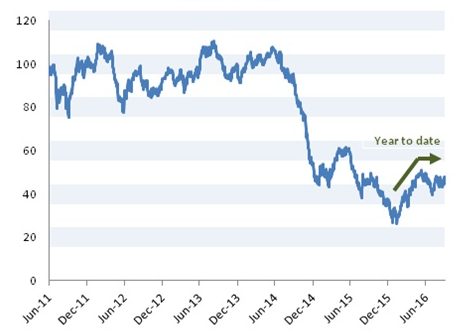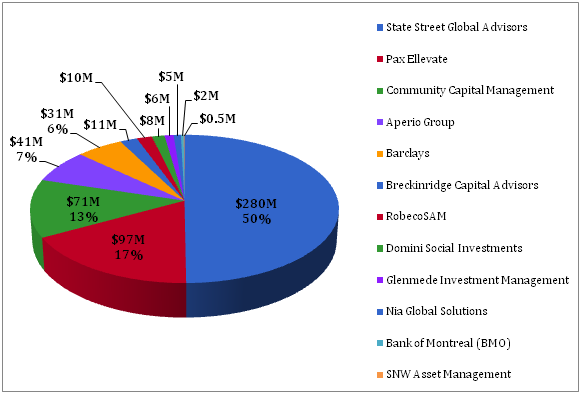Analyzing The Phenomenal Growth Of Impact Investing
By Michael Lent, Partner, CIO
US SIF: The Forum for Sustainable and Responsible Business released its 2016 Biennial Report on US Sustainable, Responsible and Impact Investing Trends, and there was much good news in it.
The report, issued on Nov. 14, found that over $8.72 trillion in assets – or one in five dollars invested under professional management in the US – are now invested using sustainable, responsible and impact investing criteria. This total is up 69% from 2014. There are now hundreds of investment options across all asset classes a trend that has been growing substantially over the past several decades.
This is truly remarkable, but it wasn’t so long ago that things were very different.
When I began my career, Impact investing was in its infancy. I remember attending a Council on Foundation conference in 1995 with a dozen foundation representatives discussing what we called back then, “Socially Responsible Investing.” Twenty-one years later, I spoke on a panel at the Mission Investors Exchange conference, presenting to several hundred foundations and close to five hundred attendees focused exclusively on impact investing.
In the intervening 20+ years, Impact Investing went mainstream. Institutional investors are incorporating ESG (Environmental, Social and Governance) factors into their investment process, and traditional investment management firms are increasingly offering ESG investment options.
At the same time, companies around the globe are rapidly integrating sustainability into their core business models to increase their competitiveness, innovation and lower risks. We are moving from a time of carrot and stick approach to corporate change. Increasingly we have sustainable companies receiving investments from impact investors. This is a virtuous cycle and it is important to put into perspective how far we have come. We’ve come a long way.
Underlying Trends
In my view, three key trends were made abundantly clear in this report.
First is the rapidly growing interest in climate investing. More than $2.15 trillion of institutional assets apply climate change criteria. This is a manyfold increase, and it reflects a growing awareness among large institutions about climate change risk. Institutional investors’ increasing focused on this issue could lead companies to track their carbon output, to identify ways to lower it, and to provide innovative, low-carbon products and services. It is one reason to have optimism about the future of the planet, despite the recent election results. As a strong supporter of climate change solutions, we help many clients divest from carbon intensive industries and invest in other solutions.
Second is the growth of the community investing field. The assets invested in Community Development Financial Institutions have doubled from $60 billion to $120 billion in two years. These are the credit unions, banks and community loan funds that provide financing for critical affordable housing, social services, and small businesses in low-income communities and communities of color. Historically, CDFIs have received most of their funding and capital from public sources or from banks and insurance companies under the Community Reinvestment Act. On a very hopeful note, private investors significantly increased their assets in community investing. There are great social, environmental and economic challenges in low-income communities. Access to capital is essential to long-term change in these communities.
Third, while a significant number of managers and investors say they are implementing ESG, it is not clear exactly what that means. As an industry, there is definite room for improvement and transparency. Today, many managers are not specific about how they integrate ESG factors into their investment process. This vague application of ESG criteria is due to the lack of deliberate investment process. Some funds and managers want to be seen as “doing ESG investing to respond to client demand,” but are unsure of what to do. For investors, you cannot simply pick an “SRI” fund and be satisfied that it actually has social impact. You must also understand what the manager is really doing to create impact.
Where We Go From Here
Looking ahead, I think the US SIF Trends report brings up four things we should think about:
- While we have made great strides in offering more investment options, we still need more investment solutions across different impact themes, such as Gender Lens Investing, sustainable real assets, and on broader ownership strategies.
- We need greater transparency from ESG managers and funds, so we can understand if they are actually having any impact. It’s not enough to say we do SRI. Investors need to know what and how managers are creating impact.
- Investors shouldn’t underestimate the importance of finding a wealth manager or advisor who understands the impact field. There is a fair amount of complexity and a need to sort out the managers and funds that best fit your specific financial and impact goals.
The good news is that we’re making real progress in changing the way people and institutions invest. Together, we can keep it going and bring about even more positive change.
To read Veris white papers on climate change, gender lens investing and other topics, please visit the Research section of our website.
Photo Credit: Ronald Tagra














